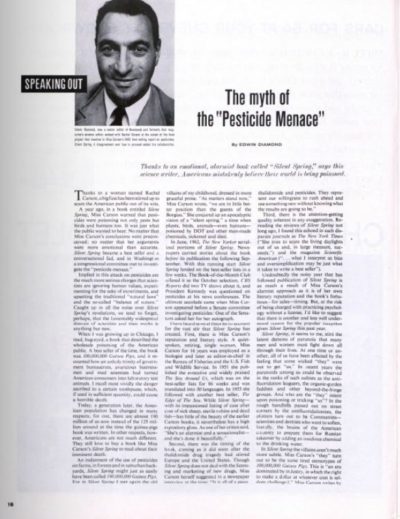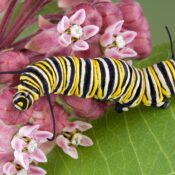Was she a communist? A new McCarthy? These were the strikingly antithetical allegations mounted against Rachel Carson after she published Silent Spring — an influential work of environmentalism released 55 years ago today.
The book was an indictment of the widespread use of petrochemical-based pesticides developed during World War II in the U.S. Silent Spring made a bold claim: “For the first time in the history of the world, every human being is now subjected to contact with dangerous chemicals from the moment of conception until death.” Carson examined studies of the effects of chemicals like DDT on the human body, citing the range of concoctions used on farmlands, roadsides, and, sometimes, sprayed liberally over vast areas. She tracked the pesticides’ and herbicides’ movement through waterways as well as the food chain and alerted the public to DDT’s murderous effects on bird populations across the country.
Carson’s shocking scientific account met instant backlash. One of her critics wrote an editorial in this magazine in 1963 called “The Myth of the ‘Pesticide Menace.’” Edwin Diamond was a senior editor — and former science editor — of Newsweek who had originally planned to coauthor Silent Spring with Carson. His critique of her work contains more thinly-veiled sexism than scientific refutation. Diamond writes that “her arguments were more emotional than accurate” and dismisses the success of the book as a result of good timing and “graceful prose,” calling it the work of an era of “shrill voices.”
After declaring the “pesticide menace” a myth, the author’s argument shrinks in scope to merely chip away at Carson’s credibility with rhetorical questions like why “an industrialist or a scientist…would poison our food and water — the same food and water he himself eats and drinks?”
Over and over in his criticism, Diamond points to the grand accusations of Silent Spring with incredulity and little else: “What, finally, is Silent Spring’s game? If we were to believe Miss Carson’s own description of our times — an era where the right to make an irresponsible dollar is seldom challenged — then the answer would be an easy one. But I believe this description, like so much else in Silent Spring, is an extravagant one.” Diamond wrote this before the Exxon Valdez oil spill, Love Canal, Three Mile Island, the Deepwater Horizon oil spill, the West Virginia chemical spill, and numerous other environmental disasters brought about by apparent corporate malfeasance.
Regardless of the criticism of The Saturday Evening Post — or Forbes, Time, or The National Review — Silent Spring gained widespread acclaim and led to a Kennedy-appointed panel to research its findings. The formation of the Environmental Protection Agency in 1970 and the banning of DDT in 1972 followed. Al Gore placed it “among the rare books that have transformed our society.”
Attacks on Silent Spring and the ideas it put forth are still numerous. Their intentions, however, are sometimes more transparent, like the website www.rachelwaswrong.com, which alleges “her extreme rhetoric generated a culture of fear.” The site is run by the Competitive Enterprise Institute, who is in turn sponsored by corporations from Monsanto to Murray Energy to the Charles Koch Foundation. An article titled “Rachel Carson’s Genocide” in Capitalism Magazine speaks to another side of sensationalism.
Carson’s book is neither a hysterical call for Stone Age living nor an emotionally spun tale of the apocalypse. Silent Spring is a plea for more time, research, and deliberation regarding decisions we make for our environment — and ourselves. As the last 55 years have unfolded, we’ve seen the negative human impact on biodiversity worldwide, plastic fibers turning up in over 80 percent of global water samples, and an annual “dead zone” the size of New Jersey in the Gulf of Mexico, where a regular influx of field runoff creates a spot where fish cannot survive. The irony — though certainly not comedic — is that our own harm stems from our tireless efforts of survival, short-sighted as they may be.
Become a Saturday Evening Post member and enjoy unlimited access. Subscribe now





Comments
Brilliant article from start to finish Nicholas. Everything Rachel Carson said 55 years ago had already been true for about 20 years. The fact she was a woman (God forbid!!) automatically rendered anything SHE would say as nonsense and “the ramblings of a woman”. Bull—-!
Even if the same book had been written by a ‘Roger Carson’ instead, he still would have gotten plenty of flack, but to a lesser degree. 1962 was still an era when if something wasn’t working right, you’d take it to a repair shop—-and actually have it repaired! Planned obsolescence was not the problem it would later become.
Everything is just disposed of, especially in the last 2 decades; mainly tech devices with their toxic, environment destroying insides. The U.S. has done its fair share of dumping stuff they’re not allowed to here, overseas.
The problems are how many hundreds or thousands of times worse now than 55 years ago, and the denial/greed is worse than ever. I don’t think there’s anything that can really be done. Fortunately there are GMO-free foods, natural alternatives on a lot of things, hybrids. People are also re-cycling now, so at least there are some positives on an otherwise unarguably bleak situation. Regardless, if she were alive today, Rachel Carson would be beyond horrified.